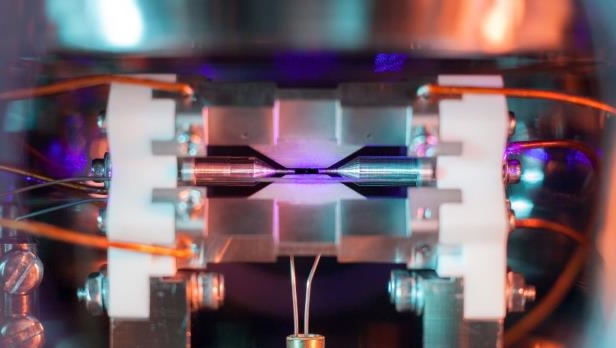A student at the University of Oxford is being celebrated in the world of science photography for capturing a single, floating atom with an ordinary camera.
David Nadlinger captured the winning photo of an atom suspended between electric fields using a standard digital single-lens reflex camera, the council that organized the U.K. photography competition announced on Monday.
“The idea of being able to see a single atom with the naked eye had struck me as a wonderfully direct and visceral bridge between the miniscule quantum world and our macroscopic reality,” Nadlinger said according to an Engineering and Physical Sciences Research Council press release.
“A back-of-the-envelope calculation showed the numbers to be on my side, and when I set off to the lab with camera and tripods one quiet Sunday afternoon, I was rewarded with this particular picture of a small, pale blue dot,” he added.
Nadlinger, a Ph.D. student in physics, traps atoms as part of his research on quantum computing at Oxford’s Clarendon Laboratory. Atoms are incredibly small, but he used a few tricks to make the atom visible to the human eye in a photograph.
The researcher first turned the atom of strontium, the 38th element on the periodic table, into an ion ― an atom with a positive or negative net electric charge. Nadlinger then used currents that four needle-shaped electrodes emitted to isolate and suspend the ion. He illuminated it with a blue-violet colored laser and took the photo through the window of a vacuum chamber, using an exposure time of 30 seconds.
The pale dot that Nadlinger captured is not the true size of the strontium atom, however. The atom is actually re-emitting the light from the lasers to create a glow that is hundreds of times wider than its radius.
“I think people are … surprised by how big the atom looks here,” Nadlinger told LiveScience. “I hope I’m not undoing 100 years of science education with this photo — atoms actually are unbelievably small!”
The research council received over 100 entries this year for its fifth science photography competition. Other winning images included a colorful close-up photo of spherical soap bubble about to burst in a kitchen sink and a photo of a volunteer wearing a headset that records brain activity while walking along a road in Edinburgh, Scotland.
















One would have expected that an article about a groundbreaking photograph would have actually included the photograph that was being spoken of.
They actually did include the photograph, however, you would have to zoom in to actually see a picture of it.